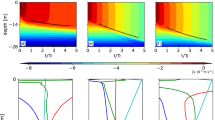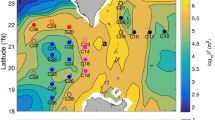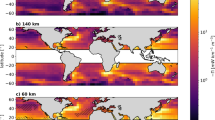Abstract
THE formation and evolution of mixed layers in the surface waters of the oceans are important in many fields of study and much effort has been expended towards the development of predictive models of the wind-mixed surface layer1,2. These models parameterise small-scale high-frequency turbulent mixing processes, which are difficult to measure, in terms of more easily observed variables such as the wind stress. Because this parameterisation depends on hypotheses about the character of the turbulent mixing which dominates the transport of heat and momentum, it is vital to have a realistic concept of the turbulent processes in active mixing layers. It is often assumed that a major source of turbulence at the base of the mixed layer is the shear between the mean currents in the mixed layer and those in the thermocline. Simple shear turbulence of this sort often may be described by a flux-gradient relationship3. We have now found that although a flux-gradient description is adequate most of the time at the base of an actively mixing layer, during a storm isolated and relatively rare large-scale catastrophic mixing events, which cannot be described by a flux-gradient relation, can dominate transport. Although these catastrophic events occur infrequently, the vertical heat transport associated with them can dominate the continuous transport associated with flux-gradient processes.
This is a preview of subscription content, access via your institution
Access options
Subscribe to this journal
Receive 51 print issues and online access
$199.00 per year
only $3.90 per issue
Buy this article
- Purchase on Springer Link
- Instant access to full article PDF
Prices may be subject to local taxes which are calculated during checkout
Similar content being viewed by others
References
Niiler, P. P. J. mar. Res. 33, 405–422 (1975).
Niiler, P. P. & Kraus, E. B. in Modelling and Prediction of the Upper Layers of the Ocean, 143–172 (Pergamon, Oxford, 1977).
Tennekes, H. & Lumley, J. L. A First Course in Turbulence (MIT Press, 1973).
Caldwell, D. R., Wilcox, S. D. & Matsler, M. Limnol. Oceanogr. 20, 1035–1047 (1975).
Desaubies, Y. J. F. & Gregg, M. C. Deep-Sea Res. (submitted).
Turner, J. S. Buoyancy Effects in Fluids (Cambridge University Press, London, 1973).
Author information
Authors and Affiliations
Rights and permissions
About this article
Cite this article
DILLON, T., CALDWELL, D. Catastrophic events in a surface mixed layer. Nature 276, 601–602 (1978). https://doi.org/10.1038/276601a0
Received:
Accepted:
Issue Date:
DOI: https://doi.org/10.1038/276601a0
This article is cited by
-
Water-column studies near a melting Arctic iceberg
Polar Biology (1983)
Comments
By submitting a comment you agree to abide by our Terms and Community Guidelines. If you find something abusive or that does not comply with our terms or guidelines please flag it as inappropriate.



